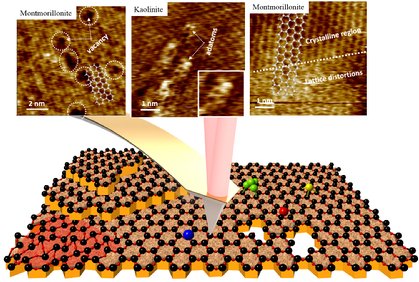Atomic scale details of surface structure play a crucial role for solid-liquid interfaces.
While macroscopic characterization techniques provide averaged information about bulk and interfaces, high resolution real space imaging reveals unique insights into the role of defects that are believed to dominate many aspects of surface chemistry and physics. Here, we use high resolution dynamic Atomic Force Microscopy (AFM) to visualize and characterize in ambient water the morphology and atomic scale structure of a variety of nanoparticles of common clay minerals adsorbed to flat solid surfaces. Atomically resolved images of the (001) basal planes are obtained on all materials investigated, namely gibbsite, kaolinite, illite, and Na-montmorillonite of both natural and synthetic origin. Next to regions of perfect crystallinity, we routinely observe extended regions of various types of defects on the surfaces, including vacancies of one or few atoms, vacancy islands, atomic steps, apparently disordered regions, as well as strongly adsorbed seemingly organic and inorganic species. While their exact nature is frequently difficult to identify, our observations clearly highlight the ubiquity of such defects and their relevance for the overall physical and chemical properties of clay nanoparticle-water interfaces.
This research was published in Nanoscale: http://pubs.rsc.org/en/content/articlehtml/2016/nr/c6nr01403h?page=search






